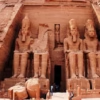Egypt, the “Land of the Pharaohs,” boasts one of the world’s oldest and most captivating cultures. With a history spanning 5,000 years, it has profoundly influenced art, architecture, religion, and science. This article explores Egypt’s cultural milestones—from the pyramids to modern music.

1. Ancient Egypt – The Cradle of Civilization
1.1 Pharaohs and Divine Pantheon
- Governance: Pharaohs were god-kings, mediators between deities and humans.
- Key Deities:
- Ra (Sun God)
- Isis (Goddess of Magic)
- Anubis (God of Mummification)
1.2 Monumental Architecture
- Pyramids of Giza (Ancient Wonder, Pharaohs’ Tombs)
- Temple Complexes (Karnak, Luxor, Abu Simbel)
- The Sphinx – Symbol of Power
1.3 Writing and Science
- Hieroglyphs (Among the earliest scripts)
- Medicine (Pioneering surgical techniques)
- Astronomy (Calendar system)
2. Egypt Under Foreign Rule – Greco-Roman Influences
2.1 Ptolemaic Period (332–30 BCE)
- Alexandria emerged as a cultural hub.
- Library of Alexandria – Ancient knowledge repository.
2.2 Roman and Byzantine Era
- Spread of Christianity (Rise of the Coptic Church).

3. Islamic Golden Age – Arab Culture and Architecture
3.1 Advent of Islam (7th Century)
- Cairo flourished under the Fatimids.
- Al-Azhar University (Among the world’s oldest).
3.2 Mamluks and Ottomans
- Mosques like Ibn Tulun.
- Bazaar Culture (Khan el-Khalili).
4. Modern Culture – Tradition Meets Globalization
4.1 Literature and Film
- Naguib Mahfouz (Nobel Prize-winning author).
- Egyptian Cinema (“Golden Age” in the 1950s).
4.2 Music and Dance
- Umm Kulthum – Iconic vocalist.
- Tanoura Dance (Sufi-inspired).
4.3 Daily Life
- Teahouses as social hubs.
- Traditional Festivals (Ramadan, Sham el-Nessim).

5. Preserving Egypt’s Heritage – Challenges Today
- Tourism as an economic pillar.
- Looting vs. Conservation of antiquities.
Conclusion
Egypt’s culture is a mosaic of pharaonic legacy, Islamic art, and contemporary life. Its impact endures globally—in architecture, religion, and pop culture.





